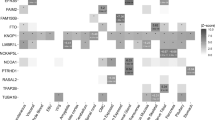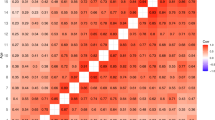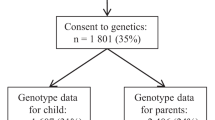Abstract
Background/Objectives
Empirical data consistently suggest high heritability estimates for adiposity, with heritability peaking during childhood. However, no study has considered the potentially shared genetic and environmental etiologies of the three most commonly used adiposity metrics — body mass index (BMI), waist circumference, and percent body fat. We examined the genetic and environmental contributions to BMI, percent body fat, and waist circumference, and the extent to which their genetic and environmental variances overlap during middle childhood.
Subjects/Methods
We examined the genetic and environmental contributions to BMI, percent body fat, and waist circumference in a community sample of twin children (N = 254–326 pairs; female=47.8–49.9%; Non-Hispanic White=51.9–59.5%, Hispanic=29.5–35.7%) studied at ages 8, 9, 10, and 11 years by comparing the fit of two models: the independent and common pathway models.
Results
The common pathway model yielded the most parsimonious fit, indicating that covariance between indicators was best represented by a single highly heritable common latent factor. This common factor explained 97-98% of the variance in BMI regardless of age, whereas indicator-specific genetic and environmental influences explained 10–17% of the variance in percent body fat and 14–29% of the variance in waist circumference.
Conclusions
Our findings support a highly heritable common adiposity factor for BMI, body fat, and waist circumference in a community sample of youth, and suggest that BMI is a useful measure of adiposity in large-scale epidemiological studies with limited resources in middle childhood. When resources permit, including other adiposity indicators such as percent body fat and waist circumference can provide more precise assessments for specific subgroups. Our study highlights the need for individualized approaches to managing childhood adiposity, recognizing the strong genetic component and the variability in how children respond to their environments. Theories of the etiology of childhood obesity should accommodate genetic influences to optimize prevention and intervention efforts.
This is a preview of subscription content, access via your institution
Access options
Subscribe to this journal
Receive 12 print issues and online access
$259.00 per year
only $21.58 per issue
Buy this article
- Purchase on SpringerLink
- Instant access to full article PDF
Prices may be subject to local taxes which are calculated during checkout



Similar content being viewed by others
Data availability
The datasets generated during and/or analyzed during the current study are available from the corresponding author upon reasonable request.
References
Dixon JB. The effect of obesity on health outcomes. Mol Cell Endocrinol. 2010;316:104–8.
Fontaine KR, Barofsky I. Obesity and health-related Quality of Life. Obes Rev. 2001;2:173–82.
World Health Organization. Obesity [Internet]. World Health Organization. 2024. Available from: https://www.who.int/health-topics/obesity#tab=tab_1
Barton M, Baretella O, Meyer MR. Obesity and risk of vascular disease: importance of endothelium-dependent vasoconstriction. Br J Pharmacol. 2012;165:591–602.
Centers for Disease Control and Prevention. Consequences of Obesity [Internet]. Centers for Disease Control and Prevention. 2022. Available from: https://www.cdc.gov/obesity/basics/consequences.html
Xiong Y, Tang Y, Zhou J, Tian Y, Chen F, Li G, et al. Childhood Adiposity and Risk of Major Clinical Heart Diseases in Adulthood: A Mendelian Randomization Study. Journal of the American Heart Association. 2024 Aug 6 [cited 2024 Aug 21];13.
Kang MJ. The adiposity rebound in the 21st century children: meaning for what?. Korean J Pediatr. 2018;61:375–80.
Simmonds M, Llewellyn A, Owen CG, Woolacott N. Predicting Adult Obesity from Childhood Obesity: A Systematic Review and Meta-Analysis. Obes Rev. 2016;17:95–107.
Juonala M, Magnussen CG, Berenson GS, Venn A, Burns TL, Sabin MA, et al. Childhood Adiposity, Adult Adiposity, and Cardiovascular Risk Factors. Obstet Gynecol Surv. 2012;67:156–8.
Prentice AM, Jebb SA. Beyond body mass index. Obes Rev [Internet]. 2001;2:141–7.
Wu Y, Li D, Vermund SH. Advantages and Limitations of the Body Mass Index (BMI) to Assess Adult Obesity. Int J Environ Res Public Health. 2024;21:757.
Freedman DS, Sherry B. The Validity of BMI as an Indicator of Body Fatness and Risk Among Children. Pediatrics. 2009;124:23–34.
Jeong SM, Jung JH, Yang YS, Kim W, Cho IY, Lee YB, et al. 2023 Obesity Fact Sheet: Prevalence of Obesity and Abdominal Obesity in Adults, Adolescents, and Children in Korea from 2012 to 2021. J Obes Metab Syndr. 2024;33:27–35.
Ogden CL. High Body Mass Index for Age Among US Children and Adolescents, 2003-2006. JAMA. 2008;299:2401–5.
Heymsfield SB, Peterson CM, Thomas DM, Heo M, Schuna JM. Why are there race/ethnic differences in adult body mass index-adiposity relationships? A quantitative critical review. Obes Rev. 2015;17:262–75.
Humphreys S. The Unethical Use of BMI in Contemporary General Practice. Br J Gen Pract. 2010;60:696–7.
Muscogiuri G, Verde L, Colao A. Body Mass Index (BMI): Still be used?. Eur J Intern Med. 2023;117:50–1.
Morse LR, Geller AI, Battaglino RA, Stolzmann K, Matthess K, Lazzari A, et al. Barriers to providing dual energy x-ray absorptiometry services to individuals with spinal cord injury. Am J Phys Med Rehab. 2009;88:57–60.
Binkovitz LA, Henwood MJ. Pediatric DXA: technique and interpretation. Pediatr Radiol. 2006;37:21–31.
Sun G, French CR, Martin GR, Younghusband B, Green RC, Xie YG, et al. Comparison of multifrequency bioelectrical impedance analysis with dual-energy X-ray absorptiometry for assessment of percentage body fat in a large, healthy population. Am J Clin Nutr. 2005;81:74–8.
Khan S, Xanthakos SA, Hornung L, Arce-Clachar C, Siegel R, Kalkwarf HJ. Relative Accuracy of Bioelectrical Impedance Analysis for Assessing Body Composition in Children With Severe Obesity. J Pediatr Gastroenterol Nutr. 2020;70:e129–35.
Ohri-Vachaspati P, DeLia D, DeWeese RS, Crespo NC, Todd M, Yedidia MJ. The relative contribution of layers of the Social Ecological Model to childhood obesity. Public health Nutr. 2015;18:2055–66.
Weinsier RL, Hunter GR, Heini AF, Goran MI, Sell SM. The etiology of obesity: relative contribution of metabolic factors, diet, and physical activity. Am J Med. 1998;105:145–50.
Dantas RR, Da Silva GAP. The role of the obesogenic environment and parental lifestyles in infant feeding behavior. Rev Paul de Pediatr. 2019;37:363–71.
Parks EP, Kumanyika S, Moore RH, Stettler N, Wrotniak BH, Kazak A. Influence of Stress in Parents on Child Obesity and Related Behaviors. PEDIATRICS. 2012;130:e1096–104.
Min J, Chiu DT, Wang Y. Variation in the heritability of body mass index based on diverse twin studies: a systematic review. Obes Rev. 2013;14:871–82.
Silventoinen K, Konttinen H. Obesity and eating behavior from the perspective of twin and genetic research. Neurosci Biobehav Rev. 2020;109:150–65.
Silventoinen K, Jelenkovic A, Sund R, Yokoyama Y, Hur YM, Cozen W, et al. Differences in genetic and environmental variation in adult BMI by sex, age, time period, and region: an individual-based pooled analysis of 40 twin cohorts. Am J Clin Nutr. 2017;106:457–66.
Warner ET, Jiang L, Adjei DN, Turman C, Gordon W, Wang L, et al. A Genome-Wide Association Study of Childhood Body Fatness. Obesity. 2021;29:446–53.
Elks CE, den Hoed M, Zhao JH, Sharp SJ, Wareham NJ, Loos RJF, et al. Variability in the Heritability of Body Mass Index: A Systematic Review and Meta-Regression. Front Endocrinol. 2012;3:1–16.
Haworth CMA, Davis OSP, Plomin R. Twins Early Development Study (TEDS): A Genetically Sensitive Investigation of Cognitive and Behavioral Development From Childhood to Young Adulthood. Twin research and human genetics: the official journal of the International Society for Twin Studies [Internet]. 2013 Feb 1;16:117-25.
Wardle J, Carnell S, Haworth CM, Plomin R. Evidence for a strong genetic influence on childhood adiposity despite the force of the obesogenic environment. Am J Clin Nutr. 2008;87:398–404.
Lemery-Chalfant K, Clifford S, McDonald K, O’Brien TC, Valiente C. Arizona Twin Project: A Focus on Early Resilience. Twin Res Hum Genet. 2013;16:404–11.
Lemery-Chalfant K, Oro V, Rea-Sandin G, Miadich S, Lecarie E, Clifford S, et al. Arizona Twin Project: Specificity in Risk and Resilience for Developmental Psychopathology and Health. Twin Res Hum Genet. 2019;22:681–5.
Goldsmith H. A zygosity questionnaire for young twins: A research note. Behav Genet. 1991;21:257–69.
Forget-Dubois N, Pérusse D, Turecki G, Girard A, Billette JM, Rouleau G, et al. Diagnosing Zygosity in Infant Twins: Physical Similarity, Genotyping, and Chorionicity. 2003;6:479–85.
Price TS, Freeman B, Craig I, Petrill SA, Ebersole L, Plomin R. Infant zygosity can be assigned by parental report questionnaire data. Twin Res. 2000;3:129–33.
Davis MC Measuring Adiposity in Health Research. SAGE Publications, Inc eBooks. 2008;259–76.
Muthén BO, Muthén LK. Mplus user’s guide: statistical analysis with latent variables. Los Angeles: Muthén & Muthén; 2017.
Hardy R, Wills AK, Wong A, Elks CE, Wareham NJ, Loos RJF, et al. Life course variations in the associations between FTO and MC4R gene variants and body size. Hum Mol Genet. 2010;19:545–52.
Heianza Y, Qi L. Gene-Diet Interaction and Precision Nutrition in Obesity. Int J Mol Sci. 2017;18:787.
Schrempft S, van Jaarsveld CHM, Fisher A, Herle M, Smith AD, Fildes A, et al. Variation in the Heritability of Child Body Mass Index by Obesogenic Home Environment. JAMA Pediatr. 2018;172:1153.
Gauthier KI, Krajicek MJ. Obesogenic environment: A concept analysis and pediatric perspective. J Special Pediatr Nurs. 2013;18:202–10.
Hall KD, Kahan S. Maintenance of lost weight and long-term management of obesity. Med Clin North Am. 2018;102:183–97.
Luig T, Anderson R, Sharma AM, Campbell-Scherer DL. Personalizing obesity assessment and care planning in primary care: patient experience and outcomes in everyday life and health. Clin Obes. 2018;8:411–23.
Steeves E, Martins PA, Gittelsohn J. Changing the Food Environment for Obesity Prevention: Key Gaps and Future Directions. Curr Obes Rep [Internet]. 2014;3:451–8.
Swinburn B, Sacks G, Ravussin E. Increased food energy supply is more than sufficient to explain the US epidemic of obesity. Am J Clin Nutr. 2009;90:1453–6.
Scaglioni S, De Cosmi V, Ciappolino V, Parazzini F, Brambilla P, Agostoni C. Factors Influencing Children’s Eating Behaviours. Nutrients. 2018;10:706.
Acknowledgements
We acknowledge support from the National Institutes of Health for funding this research (2R01 HD086085: MPI’s Kathryn Lemery-Chalfant & Mary Davis; 2R01 HD079520-06; MPI’s Kathryn Lemery-Chalfant and Leah Doane). We also thank the Arizona Twin Project students and staff and families, and the participating twins and families.
Author information
Authors and Affiliations
Contributions
All authors contributed to the study conception and design. Data analyses were performed by EB and SC. EB conceptualized the research questions and hypotheses, interpreted results, and drafted the manuscript. SC, MD, LD, and KL contributed to the interpretation of the data, revised the manuscript critically for important intellectual content, and gave final approval of the version to be published.
Corresponding author
Ethics declarations
Competing interests
The authors declare no competing interests.
Ethics approval and consent to participate
Arizona State University Institutional Review Board approval was obtained for all study phases prior to data collection for each phase of this study (IRB# STUDY00000637- Children’s Sleep and Health and STUDY00004309- Children’s Pain). All methods were performed in accordance with the relevant guidelines and regulations provided by the IRB. Written informed consent was provided by the participants’ primary caregivers, and verbal assent was given by twin children prior to assessments at each wave of data collection.
Additional information
Publisher’s note Springer Nature remains neutral with regard to jurisdictional claims in published maps and institutional affiliations.
Supplementary information
Rights and permissions
Springer Nature or its licensor (e.g. a society or other partner) holds exclusive rights to this article under a publishing agreement with the author(s) or other rightsholder(s); author self-archiving of the accepted manuscript version of this article is solely governed by the terms of such publishing agreement and applicable law.
About this article
Cite this article
Bartsch, E.M., Clifford, S., Davis, M.C. et al. Does a heritable common latent factor explain body mass index, percent body fat, and waist circumference across childhood?. Int J Obes (2025). https://doi.org/10.1038/s41366-025-01864-9
Received:
Revised:
Accepted:
Published:
DOI: https://doi.org/10.1038/s41366-025-01864-9



